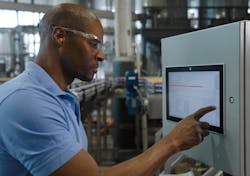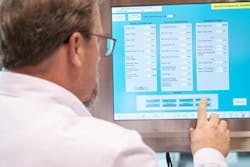HMI, Visualization and Industry’s Digital Transformation
Manufacturing enterprises encounter various hurdles related to digital transformation. One major obstacle is connectivity, stemming from legacy technology silos, diverse data formats and a lack of interoperability. Delving into these connectivity challenges reveals instances where machines on the plant floor have air gaps, hindering the extraction of data for cloud-based processes such as analytics and intelligence, which contribute to added business value.
Air gaps can be intentional security measures isolating devices or a consequence of the absence of a network switch linking information technology (IT) and operations technology (OT) devices, thereby preventing communication. In many cases, the absence of standards and application programming interfaces (APIs) further contributes to the existence of air gaps between systems.
Cost often serves as another impediment, as digital transformation initiatives often demand substantial investments in technology, enterprise-level licensing, specialized talent and infrastructure improvements. Technical debt also affects older facilities relying on legacy systems, complicating integration with new digital technologies. The complexity and time required to migrate away from these systems, coupled with the significant costs involved, pose challenges, especially for smaller organizations balancing these expenses with expected returns.
Knowledge gaps arise with the retirement of the older workforce, posing challenges for organizations focused on onboarding and advancing digital transformation. Modern HMI and visualization technologies can prove invaluable in streamlining the onboarding process, expediting digital transformation and creating opportunities for new staff with skills aligned to these technologies. Additionally, there are prospects to enhance the expertise of existing personnel through training to ensure proficiency with new products and technologies.
The convergence of IT and OT is a prevalent issue in advancing digital transformation using HMI and visualization software. Aligning disparate objectives, technologies, cultures and security considerations necessitates careful planning, collaboration and a strategic approach to bridge the gap between IT and OT domains. The smoother this convergence and the more collaborative the teams, the likelihood of success increases.
Scalability presents yet another challenge, demanding meticulous planning, resource allocation, cost management and technical considerations. Organizations must address these factors to ensure the scalability of their digital systems, meeting growing demands and performing optimally under heavy loads for sustained success.
Accelerating digital transformation Certain qualities and features are particularly critical in visualization and HMI platforms, significantly expediting the digital transformation in manufacturing across production, design and maintenance.
In the pursuit of minimizing downtime and optimizing production efficiency while eliminating defects and waste, manufacturers should prioritize the role of HMI as the central interface. The reason: HMI provides operators with real-time insights into machine, production line or system operations, connecting the plant floor to higher-level channels essential for data analytics. Visualization software, the operational core of HMI, ensures that collected data is presented in a comprehensible and actionable format, with customization for specific operations being a key aspect.
The extensibility of these systems has become pivotal, particularly in the context of Industry 4.0, where integrated systems demand flexibility, scalability and the ability to communicate with multiple controllers and systems using IoT protocols like OPC Unified Architecture (OPC UA) or Message Queuing Telemetry Transport (MQTT).
Access to historical data is crucial for runtime operations, where visualization software with an integrated data logger or historian digitizes manual tracking on the plant floor. The selection of visualization software includes consideration of an integrated data historization feature, providing operators and higher-level systems access to historical data.
On the design side of manufacturing, HMI and visualization software play a crucial role in expediting digital transformation. They offer a collaborative development environment, allowing end users to connect with design teams through SaaS (software as a service) cloud-based tools.
Cloud-based HMI tools enable developers to use centralized repositories like GitHub for code management and version control, fostering collaboration, flexibility, security and transparency. This approach facilitates simultaneous work by multiple designers, promoting efficiency and enabling the incorporation of reusable code libraries into applications.
Finally, HMI and visualization software contribute to digital transformation in machinery maintenance by empowering operators with remote access capabilities. Issues are flagged and notifications are sent to maintenance engineers, while integrated chat tools and screensharing capabilities connect on-site operators with remote technicians for issue resolution. Collaboratively, they identify necessary changes, make edits and store new versions in a secure cloud repository for effective change management.
Susan Burtch is lead commercial portfolio manager, visualization software, Rockwell Automation, and Paul Haikal is commercial portfolio manager, visualization software, Rockwell Automation.
About the Author

Leaders relevant to this article:

